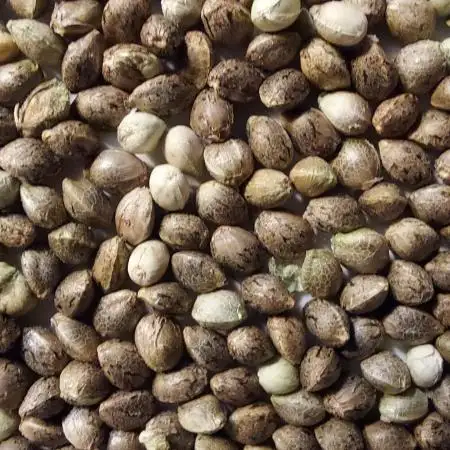The Grow Awards 2026 🏆 






















Two plants scrog not in sync
Babajipazstarted grow question 5mo ago
Hey everyone,
I'm scrogging two plants together on the same net.
Problem is, one of them had some kind of stress and stopped growing (although it looks healthy).
Can I flip to flowering even if there's a big size difference between the two (short one barely reaches the net)
Thx!
Open
Techniques. ScrOG
likes
Answer
Hightai90answered grow question 5mo ago
Switch to flower and She Will bouce back egain and maybe give a Little top tò boost the branches
likes
Complain
kingcrabanswered grow question 5mo ago
Hey growmie, that’s actually common when running two plants in the same SCROG—one always seems to take off while the other drags its feet a bit, especially if one of them had some stress earlier on.
Honestly, you can flip whenever you’re ready. The smaller one will still stretch once you switch to 12/12 and it might catch up a little. It doesn’t need to be perfectly even—plants usually surprise you once the stretch kicks in.
If you’re worried, you could bend the taller one down a bit more or give the smaller one a few extra days to push up, but personally I’d probably just go for it. Better to flip than risk the big one outgrowing the space.
Either way, you’ll be able to work with it during stretch and adjust as you go. Looks healthy overall, just a little size mismatch.
Good luck with the flip growmie 🤞🍀♥️
1 like
Complain
Core_T_Sonanswered grow question 5mo ago
Ja, kannst du ohne weiteres, stell die kleine etwas höher. Dann bekommt sie erstmal etwas mehr Licht und vielleicht etwas mehr Wachstum
Allerdings ist es grundsätzlich keine gute Idee, die Pflanze in Blüte zu schicken, wenn der Wuchs stagniert. Gib ihr lieber noch drei Tage Zeit zum erholen.
likes
Complain
00110001001001111Oanswered grow question 5mo ago
That's not shock or stress. It is genetic diversity.
You can flip to flower anytime you want.. whether no or when you fill in more scorg it is 100% up to you and you can make it work either way.
If you wait for the other one to spread out more, you may need to prune the other one back a bit... whatever it takes to even it out. I'd expect the one on the left to continue to outpace the one on the right. You can mitigate this by continuing to train the one on the left beyond flip to flower... maybe 3-5 days longer? a week? depends on the difference in vertical growth you are seeing so far (or horizontal growth in this case as you train it to the scrog, lol, not the axial growth)
Usually when you fill about 1/2 the sapce, it's good to flip. Obvioulsy 1 plant is getting there sooner. Allowing one to cover more ground can help, but once they are tangled in teh scrog, you can't really move them around much, so there is some limitation in that.
Try to train the smaller away from the larger plant and let the larger plant encroach on the smaller plant etc... Train the larger plant beyond flip while allowing the smaller plant to start growing vertically to offset inevitable height difference.
This is more art than science because you have no idea how each will grow after flip, but usually they don't change their spots drastically.
If the smaller one isn't in the net, could get a pot elevator/riser to raise it up. If not tangled in scrog, i'd shift it away from the bigger plant so the bigger plant can use up a larger portion of the space than 1/2.
any way you can slow one down and allow the other to start growing vertically earlier will help keep the canopy level later on. Anything you can do to reposition and or train the plants to better fill the area will have a positive effect on your yield.
The only way you avoid this is using clones of the same plant. PAy attention, because you'll be doing this again and the more comfortable you are the better. You understand the basics of apical dominance / training, now manipulate the plants for best results. Nothing you can do about genetic diversity but try to mitigate the differences as best you can.
1 like
Complain
m0useanswered grow question 5mo ago
Can flip yes. and when it stretches and hits the net you can work it into it. Or place the smaller plant on a riser so the canopy is the same height as the other one.
2 likes
Complain
Ultravioletanswered grow question 5mo ago
Scroggin or using a net for lateral support? If it's just for lateral support then flip away. If you are going for more of a scrogggggg the I'd flatten entire canopy best i could, but it's hard to decide if the couple weeks it would take to fill that canopy is better spent just letting her grow? That will depend on what you had in mind.
While a trellis is a more general term for any structure that provides support for climbing or vining plants. In essence, a trellis is the tool, and SCROG is one way to use that tool.
Best of luck with her she looks rdy to burst.
2 likes
Complain
Similar Grow Questions
Solved

victor_lion
week 11 of flowering and I have small attack of fungus in two buds, to avoid risks of infection, should I harvest already? , I look at all milky trichomes, but there are still many white hairs and few brown, I would like to harvest early to get a more cerebral and stimulating andWeek 21
Techniques. ScrOG
7y ago
3
3
Solved

Sup3rNov4
My First ScrogMy first ScroG how am I doing ?
Currently just started second week of stretch.
Week 7
Techniques. ScrOG
4y ago
2
2
Solved

Chanardo
Apical Cut on Auto. ¿Yes or No?I have read different opinions about make an apical cut on auto plants: someones say that it's possible and anothers say that it could affect the productions. Is it recomended to do? Is better to try with LST and ScrOG? Thanks!Techniques. LST
Techniques. HST
Techniques. ScrOG
3y ago
2
2
Solved

Dinosaur
Scog or Not? WW Hydros week 6-7So I need some advice (to scrog or not to scrog)
I'm running 4 ladies in a 1mx1m tent using DWC/Bubble buckets in week 7. Ive done topping and LST to try get them horizontal. I have a scrog net but am a bit worried there won't be enough space to scrog all 4 ladies?
Techniques. ScrOG
4y ago
2
4
Solved

CollieBuddz
Lohnt es sich ein Netz ins Zelt zu spannen, wenn ich noch mal toppen würde?
Techniques. ScrOG
5y ago
4
2
Solved

GnomeMoe
Scrog over stretching branchesNew to GrowDiaries here; first time ScrOGer, long time grower...
Any suggestions for over reaching/stretching branches in a scrog?
Short plants are farther than I’d like from the lights, stretching branches are to close to light....
Hmmm....Week 9
Techniques. ScrOG
5y ago
1
1
Solved

bobo66
Hemp twine (hemp rope) to support plants, can not cause pollination of plants?in these areas where hemp is produced for industrial use, is there a lot of male pollen, if I support my plants with it in my tent, can I cause pollination with it?
only such twines are sold in the farm shop. does anyone have experience with it? i don't want to smoke seeded grass
Other. General questions
Techniques. ScrOG
4y ago
4
7
Solved

metamon3y
First time grower. Flowering?Is she already on flowering stage or still veg?
Other. General questions
Techniques. ScrOG
2y ago
2
7
Solved

Growernotshower1
When to flip?Newbie question:
When do I flip? Worried I’ll overfill my 2x2 if I wait too long.
Week 7
Techniques. ScrOG
5y ago
2
Solved

Zennuggs
Should I continue tucking?Once I have flipped to flowering stage 12/12 light cycle, should I continue to tuck under the ScrOG? If so how long?
Other. General questions
Techniques. 12-12 from seeds
Techniques. ScrOG
5y ago
3
2
Solved

EmeraldLakeCannabis
To ScrOG or not to ScrOG?I've always used a scrog net to manage my canopy going into flower. Last run I had quite a time removing the trellis at harvest and ended up destroying it.
Should I just get a disposable trellis for this run? How were results running without a trellis?
all knowledge welcome.Techniques. ScrOG
4y ago
2
2
Solved

EvilGrower
Deep water culture trellis training? Practical?What do y'all think about a DWC with a trellis? When I started this grow I had planned to make a screen of green, but I'm not sure how practice that would be for water changes. Is it practical enough to do this method and just use a water pump for water changes?
6y ago
2
3
Solved

Wyregrasser
Should I Scrog? Confused!My garden seems healthy despite me. Guys I'm confused as to what I should do. Plans are to ScrOG at 18" (which I have never done) with a screen that is 3' x 4'. This screen would cover the entire container area plus about 4" over around the edges. Should ScrOG or just let grow?
4y ago
7
6
Solved

Overgrotho
Avoiding Too Much LIght in Flower with Co2-- PPFD/LUX QuestionI've read that cannabis maxes out at 1500 PPFD or 80,000 LUX even with CO2. If I have 720 Watts of white light LED or about 3200 PPFD in a 4x4 = way too much in the center, right? I should dim the center light by about 50% as I've done? To avoid diminished yield even with co2?Techniques. ScrOG
5y ago
1
3
















